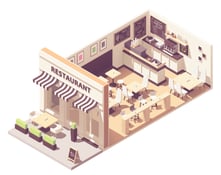Spooky season may last just one month per calendar year, but one spectral entity lingers year-round: the ghost kitchen. Prior to the outbreak of pandemic and the advent of the brave new world it ushered in, ghost kitchens were a lot like their phantasmagorical namesake. Discussed only in hushed tones, considered vaguely threatening by restaurateurs who were perfectly comfortable operating in the even braver old world of brick-and-mortar, they remained out of sight, and just a bit mysterious.
But then came 2020, and in rapid fashion, the food and beverage world underwent near-total transformations. Take out and delivery weren’t just part of the pie — for many restaurants, they saved the day, and kept growing. Restaurants you couldn’t enter began moonlighting on apps as different brands altogether. Perhaps most infamously, Pasqually’s Pizza and Wings was outed as Chuck E. Cheese, throwing business owners and consumers alike for a loop.
Those days now seem quaint. Delivery-only restaurants or brands are firmly entrenched. And you probably know some folks — you, perhaps? — who are weighing whether to open their own ghost kitchen. The model is lean enough that they can take the plunge without so much overhead, among other pros and cons to consider. You're going to need some suitable ghost kitchen tech. But even before that point, the most pressing question is: What menu items are best, most profitable, and most transportable?
“The purpose of a ghost kitchen is to minimize the brick and mortar overhead — with seats and parking, and all of the things that go along with the operating expenses of a restaurant — so you just basically have a kitchen, where you can maximize the quality of your food and get it to customers as quickly as possible,” says Walter Zuromski, President and Culinary Director of the Rhode Island-based restaurant consultant business Chef Services Group. “But you have to understand what it is you want to do. That’s the first thing.”
Ghost kitchens are still evolving at warp speed, which means some semantic slippage in terms of exactly what it is we talk about when we talk about “ghost kitchens.” Zuromski — a Certified Master Chef who brings 30-plus years of recipe and menu development to his work with national chains and nascent local eateries alike — has clients who approach the concept from several different angles. For instance: He knows of operators who work out of “some kind of industrial manufacturing space that’s been renovated to house, say, 20 kitchens that are put in according to specifications, and then delivery from however many restaurants are managed in one central location.”
This model is what Kristen Barnett, CEO of Brooklyn-based “anti-ghost kitchen” Hungry House, calls “the dark kitchen format” — a kitchen without a storefront, a concept without a public-facing physical location. (More on her spin on the model a bit later.)
Zuromski also works with existing traditional restaurants that are looking to expand into this growing corner of the industry. “We work with a restaurant company here in Rhode Island called T’s Restaurants,” he says. “They went from $300 a day in takeout in 2018 to $3,000 a day during the pandemic. We had a conversation with them: Why don’t they just close the dining room, minimize the kitchen staff, and create a ghost kitchen in the restaurant? So now you can do food that doesn’t have anything to do with the main restaurant concept.”
This is the true “ghost” kitchen: the back-of-house that keeps on cooking after the last of the customers have fled the dining room. Just as in your favorite supernatural comedies, there are ghost rules to a ghost kitchen. The biggest one is, you have to conceive of a menu that can thrive in this graveyard shift, in which foods all have a second life away from the place where they’re being prepared.
Ghost kitchen menu items that are easy to fill
What are the kinds of light-lift favorites a second-shift kitchen staff cooks up after the dining room goes dark? Comfort food, for one. “The portable, hand-held foods travel the best,” Zuromski says. “And Chinese is great, because it’s wok-cooked — it heats up fast, and it can be reheated even if it gets cold on the way to someone.”
The importance of Zuromski’s point — that integrity depends on portability — can’t be overstated. You may be able to whip up a divine order of mac and cheese in your sleep, but that’ll do you no good in the delivery world if it’s a dried-out clump-fest by the time your customer tries to stab it with a spoon.
The menu at Barnett’s Hungry House is composed of signature concepts designed by well-known chefs such as Woldy Reyes, hailed for his pop-ups offering artful Filipino fare. Barnett invited Reyes and other collaborators to participate in an iterative process to create Hungry House’s offerings. Along the way, some excellent dishes got the axe.
“When we first kicked off conversations with our partners, we said, ‘Give us your whole menu, give us your data, show us what’s selling,’” Barnett says. Woldy, for example, had a number of recipes he rolls out at events, including a gorgeous play on Cacio e Pepe with coconut milk and pink peppercorn garnish on the top. “Obviously,” Barnett continues, “that’s not going to travel. The pasta and the sauce are going to seize, and it’s going to be drier than you want. It’s great for his pop-ups, but isn’t something that we thought would survive on the menu.”
To determine the best menu options for her business, Barnett began with her customers in mind and worked backwards to find simple solutions for her chefs to execute. Hungry House operates out of the Brooklyn Navy Yard, home to dozens of businesses. In thinking about Reyes’s food, Barnett says, they considered how to feed office workers first. “His noodle salad with vegetables is going to be something healthy and fresh that people want to eat in the middle of the day,” she says. “For the mushroom adobo, we styled it as a grain bowl. It’s really beautiful, but would still be a familiar construction to an office worker, who’s used to having grain bowls.”
As a rising star operating in one of the world’s most cutting-edge culinary markets, Barnett has the know-how and resources to build workable delivery concepts from gastronomies far and wide. “We would never say no to a cuisine,” she says. “We just look for the parts of it that are going to shine in this format, and still be scalable and accessible in our context.”
Your average first-timer in the ghost-o-sphere might want to start even simpler, repurposing ingredients and materials on-hand from an existing operation. Zuromski recounted a client who had a pastry display case in his BBQ restaurant. “I said, ‘Get rid of the pastries and put in meals to go home, cooked and chilled,’ he says. “Pulled pork, spare ribs, brisket, chili, and so on — all of that does pretty well when reheated.”
Most ghost restaurateurs will want to start with the most travel-worthy elements of whatever it is they already know best. And/or, take a page out of Pasqually’s book and go with pizza. The same client that had the pastry case, Zuromski said, added pizza to his delivery menu. “Who would have thought you’d do pizza out of a BBQ joint?” the chef says. “But he’s doing so much pizza now, especially during the non-traditional hours, that he can’t take it off the menu.”
Ghost kitchen menu items you can make in advance
You know who absolutely would love a Philadelphia roll right now? Some dude sitting on his couch, apparently. A 2020 DoorDash Deep Dish report found that sushi rolls are the top-selling pre-preparable food in delivery markets across the United States and Canada. It makes sense, when you think about it, that one of the world’s most elite foods could also be a leading meal for the contentedly pajama’ed among us. Sushi travels well in industry-proven packaging, it can be kept fresh in a fridge, and it’s typically served cold.
If you’d rather cut back on your prep time altogether, DoorDash recently shared data that suggests 2021 was a banner year for DIY kits. Why bother putting together dishes that will hold in transport when you can just package up ingredients to entertain your customers at home during an umpteenth round of quarantine? Foods that lend themselves well to this approach are salads (build-your-own kit sales were up a ludicrous 465% in 2021), ice cream (up 197%), and, are you sensing a theme yet, pizza (165%).
Zuromski has a client that takes an even more high-tech version of the modular approach. The startup Platable delivers gourmet meals around New York City by making the diner a partner in creating a restaurant-quality experience at home: Everything on offer is fully cooked and vacuum-sealed, to be heated at home in boiling water. The notion is to go beyond the traditional styrofoam clamshell. Platable’s meals are prepared using sous vide and cook-chill technology in a centralized industrial location overseen by founder and owner Alexander Xenopoulos, and delivered fresh and on-demand by Platable’s own delivery fleet — no subscription required.
“Basically the idea of Platable is this: are you willing to heat your own food up, if you can get the same quality you’d get if you were sitting and eating in my restaurant?” Zuromski says. “Or do you want me to cook it and put it in a clamshell, let it sweat in that cardboard container, let it break down, let it get cold and get completely overcooked and nasty because of the distance it has to travel?”
Aspiring ghosts, take note. Your customers also have kitchens where your menu items can be reincarnated.
The most profitable ghost kitchen menu items
On the question of the best bang for your buck, ghost-kitchen-offering-wise, the food service industry is largely united: the almighty chicken wing reigns. It’s versatile, portable, and delicious — and dirt-cheap to prep.
That said, unless you’ve got a wildly new take on the classic concept, the ubiquity of the wing may work against you at this point. One of the things that inspired Barnett to go with her current model at Hungry House? “Just the fact that there are 4,200 different fried chicken virtual brands,” she says. “It’s funny, my launch week, DJ Khaled launched his concept: ‘Another Wing.’ And I was like, ‘Yeah — it is just another wing!’”
Barnett designs her dishes with her chefs’ stories in mind and on how best to translate that to the person tucking in for lunch. “We always think about how we can deliver the most value to the customer in their purchase,” she says. “So we almost plate it for what looks good, and then we value-engineer backwards to make sure that we hit the certain cost target to make it profitable. And we always focus on add-ons. Whether that’s a quick fry upcharge or beverage, we make sure it’s in the modifier set of that item.”
In all things ghost, your mileage may vary. As you design your ghost kitchen menu, your greatest tool may be a healthy willingness to try new things. “In the restaurant business, people are very set in their ways,” Zuromski cautions. “Some people say, ‘This is how I’ve always done it.’ And, historically, those people who haven’t changed have closed. To the people who aren’t willing to adapt, I say, ‘I just wish you luck. I wish you a lot of luck.’”
[Photo by Inna Podolska on Unsplash]




